
CATEGORIES:
BiologyChemistryConstructionCultureEcologyEconomyElectronicsFinanceGeographyHistoryInformaticsLawMathematicsMechanicsMedicineOtherPedagogyPhilosophyPhysicsPolicyPsychologySociologySportTourism
I 1.2- GREEN FINISHING
This is when the Workability" of the item is at its maximum; its plasticity allows work to be carried out quickly and any defects to be corrected with relative ease. Howev er, the material is not mechanically strong so all work needs to be carried out with due care and attention to prevent the creation of further defects.
Finishing can be carried out immediately after de-moulding or after a varying period of time to allow partial hardening. It can gent-rally be stated that more expert finishing technicians are able to begin work sooner as they are less likely to generate softness-related faults; those with less experience need to wait longer to prevent the risk of serious damage to the article.
Moisture content prevents the formation of dust that could be harmful to the operator so finishing is performed without the need for special extraction system*
 |
Finishing tools:
Metal or plastic spatulas: used to eliminate most surface blemishes and/or any excess adhesive (fig. 213 and 214-);
2S3
 |
• Sponge pads these come in various types: coarser, moie abrasive pads are used for initial finishing (fig. 21C). The latter leaves grooves on the surface of the sanitaryware. I- inn -grain, softer pads (fig, 2 15) are used to complete finishing and leave the surface as even as possible;

Ceramic Sa n ita rywa re Tech no logy
 |
Metal punches - of varying diameter depending on the hole to be made. Must be kept sharp so the resulting hole is always perfect (fig, £ 17);
Knives and razors - used to cut/shave off portions of" the ceramic to eliminated such as a part of the rim on single-cut WCs, or the elimination portions of excess slip where faulty, broken plaster moulds have been empio (fig. S 19);
Fig. 2t9- Finishing tur rft
 |
Other tools - to cheek the article or finish parts that are particularly difficult to reach: mirrors, small brushes, rods etc.
Green finishing generally involves wiping the coupling surfaces of the moulds with a long spatula to eliminate burr. Unneeded or excess parts of the article are cut away; then a coarse pad is run over the surfaces. The holes necessary for installation and use of the article are made, while any casting process holes that concern parts through which water will be flowing are sealed. The latter are sealed with pieces of specially cast biscuit or plugged with trimmed off-cuts that are then smoothed by hand or with special tools (fig. l220).
To conclude the article is wiped with a fine-grain sponge pad to make surfaces smooth and even and eliminate any blemishes that may have been caused by previous tasks.
2SS

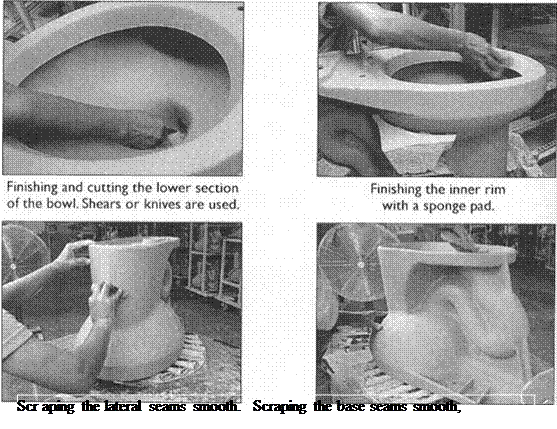 Toh. 3S Finishing (asks on a WC bozd.
Toh. 3S Finishing (asks on a WC bozd.
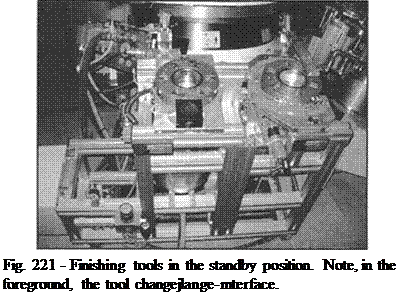 |
At this stage there is a distinct difference between articles cast in plaster and those cast in resin. Because of the nature of plaster moulds, the entire surface of the articles cast in them needs to be sponged smooth because the slow pouring process creates a ripple' effect. High pressure casting, instead, produces a much smoother, more homogeneous surface, meaning that only those parts that have undergone a previous finishing task need to be sponged down.

Automatic finishing is generally carried out by a robot. Programming of the robot requires secure, reliable positioning of the unfiled article. Por this reason camera-equipped vision systems may be installed along the production line.

The robot employs different tools for different tasks, thus reproducing the manual ersatility of an operator:
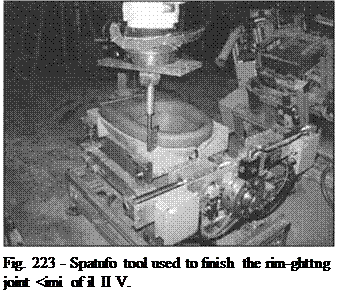 |
• Spatula - mechanical arm with a plastic spatula on its end. Used to remove finishing burr;
 |
• Sponge pads - used to finish the holes made directly inside the mould;
 |
Belt tool - this is similar to a sanding belt, but mailt- of soft lelt as opposed to glass pajier. An elei, trie motor drives the belt; motor speed is adjustable By passing it over all those surfaces on which finishing is required at a different angle a homogeneous surface suitable for glazing is obtained. An automatic system keeps the belt clean. These tools are a good alternative to spatulas or can be used as a follow-up to make sanitaryw are article joins moi e even;
Punching station equipped with two compressed air guns thai alhm rotation of steel punches; the latter make the holes that will allow installation and use
Geremie Sanitarvware Technology
 |
of the sanitaryware item. The article is transferred to the punching station b] a robot (see fig. lAc2l);
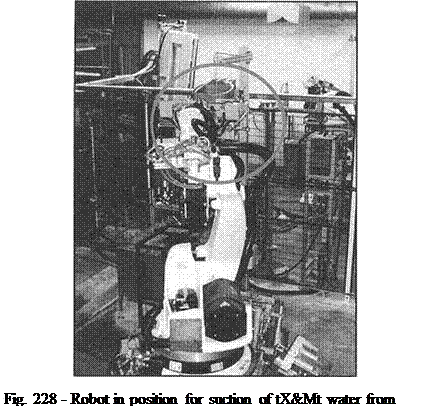 |
Water removal station - a vacuum is applied to special nozzles to suck up water contained in the sanitarvware cavities.
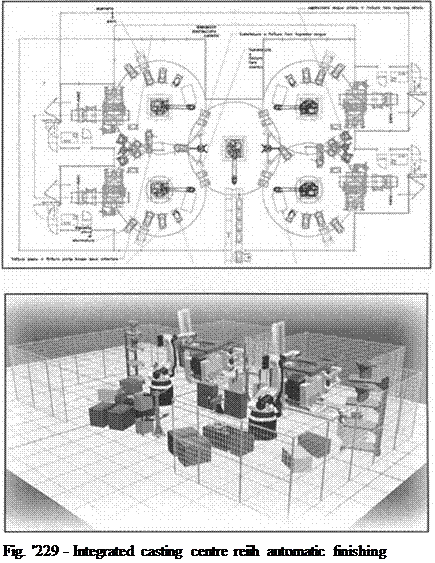 |
Finishing can only be carried out by a robot where high pressure casting systems have been installed: only a fixed capital investment such as a pressure casting machine is able to justify the use of such finishing techniques. Moreover, the excellent consistency of the unfired pieces and their precise positioning allow the necessary standardisation of robot movement. With plaster moulds, instead, each casting produces pieces of varying dimensions with different defects (because the fragility of the moulds themselves often means that their edges can undergo minor damage, augmenting the amount of burr at the joins), thus making robot programming impossible. Note also that plaster mould production plants require more floor space than their casting press counterparts, so greater investment in sanitaryvv are transfer and holding systems is required.
Date: 2015-04-20; view: 1791
| <== previous page | | | next page ==> |
| I I.I - GENERAL ASPECTS | | | I 2.2 - AUTOMATIC GLAZING |